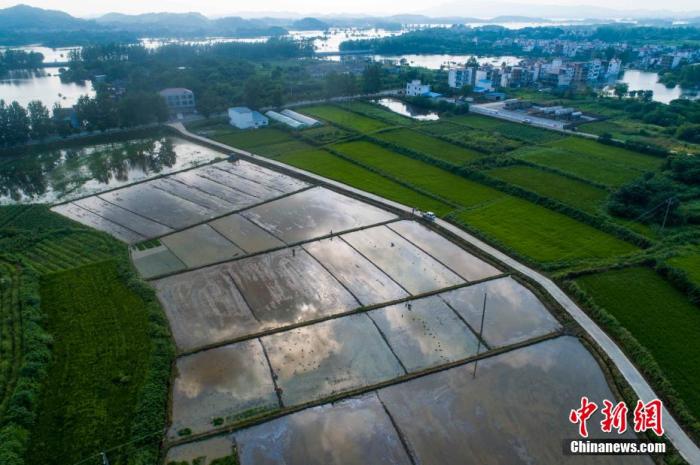China News Service, July 23. According to the website of the Ministry of Agriculture and Rural Affairs, on the 23rd, the Ministry of Agriculture and Rural Affairs dispatched 8 more working groups to Anhui, Jiangsu, Jiangxi, Shandong, Henan, Hubei, Hunan, Chongqing and other provinces (cities) have carried out disaster relief guidance, and formulated and issued technical opinions on post-disaster recovery of plantation in the middle and lower reaches of the Yangtze River to guide post-disaster production recovery in various regions.
The picture shows on July 21, after the flood subsided, farmers in Hukou County, Jiangxi Province were planting late rice while planting seedlings. Photo by Li Xuehua
Since June, continuous heavy rainfall has occurred in the middle and lower reaches of the Yangtze River, and floods have occurred in some areas, which has severely affected agricultural production. After the disaster occurred, the Ministry of Agriculture and Rural Affairs was based on the fight against the disaster to achieve a good harvest, strengthened the guidance of agricultural production in the disaster-stricken areas, and minimized the losses caused by the disaster.
Based on the previous flood relief working group dispatched, the Ministry of Agriculture and Rural Affairs sent another 8 working groups on July 23 to Anhui, Jiangsu, Jiangxi, Shandong, Henan, Hubei, Hunan, Chongqing and other provinces (cities) to carry out disaster relief guidance. It also formulated and issued technical opinions on post-disaster restoration of planting industries in the middle and lower reaches of the Yangtze River to guide post-disaster production recovery in various regions.
The working group will go deep into the front line of flood relief, check the disaster situation on the spot, and guide farmers to implement various measures for post-disaster production recovery. One is to promote the restoration of agricultural production. Instruct local governments to increase the dispatching of machinery and tools, and rush to drain water in the field. Strengthen the deployment of early rice harvesters and dryers to rush to harvest and dry early rice to ensure that the pellets are returned to the warehouse. Guide farmers to expand double-season late rice planting, "turn early and late" according to local conditions, and speed up planting progress. At the same time, guide all localities to do a good job in the recovery of livestock and fishery production after the disaster.
The second is to do a good job in the prevention and control of animal and plant diseases. Instruct the disaster-stricken areas to continue to do a good job in disinfection and elimination of sources, increase inspections of rivers and lakes, and timely detect and deal with drowning livestock and poultry to ensure that no epidemic occurs. Guide the monitoring and control of grassland spodoptera and rice "two-migration" pests, reduce the damage of disease and insects, and achieve "grain by insects".
The third is to help solve practical difficulties. In conjunction with local agricultural and rural departments, according to the development of the disaster situation, improve the technical plan for agricultural production recovery after the disaster, and help coordinate the actual difficulties and problems such as the adjustment and transportation of materials needed for agricultural production recovery.

